Tom Hunter is a photographer of whom I was made aware several years ago, although admitting to not know all of his work, his photographs influenced by Vermeer do come to the forefront of my mind when he is mentioned; those and the Unheralded Stories set.
Although I enjoyed both the contrast in the two talks could not be more different. Whereas Don McCullin sat, suited and booted, on a high stool, introduced by one person, interviewed by another with answers that seemed to be too "pat" Tom Hunter wandered in, casually attired, adjusted his own overhead projector with no regards to health and safety and addressed us as if we we all mates down the pub together! It made for a very relaxed and humorous atmosphere.
Born and bred in Dorset Tom didn't move to Hackney until 1986, he spent time working as a tree surgeon both here and in the USA. He began his talk by telling us how he was influenced by his father and the darkroom they had in the garden, the magic of seeing an image appear as if from nothing. Despite this early introduction it wasn't until he was older, and running a market stall in East London, that he started to take photographs of his customers. He found it easy to take photographs under these circumstances as he described it "my space, my stall."
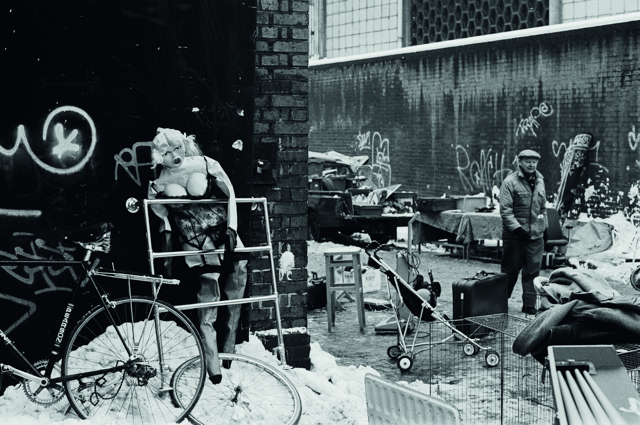
Brick Lane
His main way of working seems to be photograph what you know, explore your own surroundings. Or at least that's what came across from listening to him and looking at the work he produces. Thinking about how this applies to my own work, I'm still not happy with my assignment one really and have come to the conclusion that in part that is because my current neighbourhood isn't where I grew up. I moved here when I married and despite that being some time ago I still don't feel that this is "my" neighbourhood. Something to investigate further I feel.
Tom decided to learn the art and craft of photography by taking up an A Level evening class at Kingsway College London. At the time he was living in a squat in Ellingfort Road which was known as The Ghetto. Whilst working on his Bachelors from the London College of Printing he took inspiration from the media representation of his friends from this area and how they lived. The council attitude was that they were "scum" and the area "crime ridden" when the facts of the matter were many were improving the homes, keeping the area thriving and many of the occupants were doctors or architects.
The initial plan was to destroy all the homes and replace it with a frozen chicken warehouse! Once again using his intimate knowledge of the area and it's occupants Tom photographed the houses and the people. Using mixed media he created a scale model of the streets which was originally meant to last for the degree show but has found its way to permanent display at The Museum of London.


Tom Hunter and 'The Ghetto'
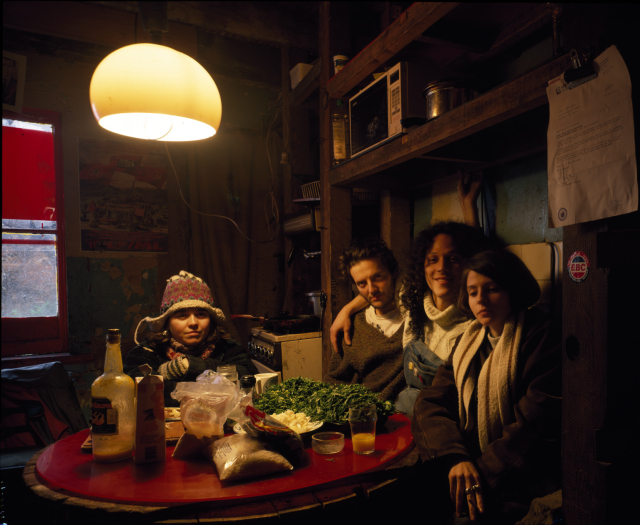
From The Ghetto Series
His campaign attracted interest with articles being written about him and this eventually paid off.

He continued his studies doing an MA with the RCA and returned to the streets influenced by Dorothea Lange's representation of the poor and dispossessed. Throughout his talk Tom flicks through a chronological slideshow of his work and at this point we encounter probably one of his better known images from the series Persons Unknown.
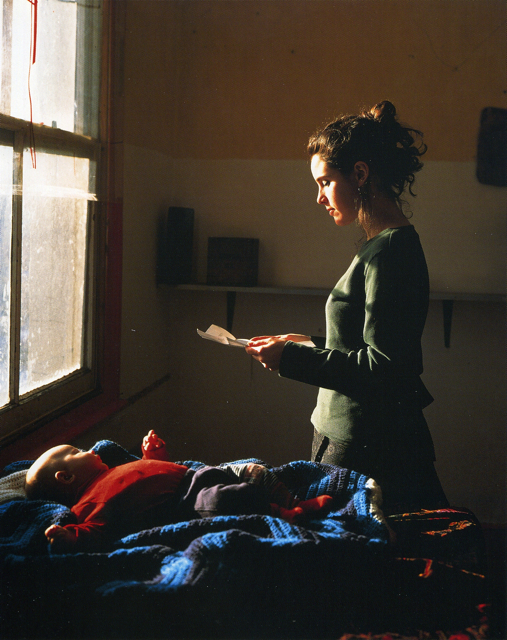
Woman Reading a Possession Order from Persons Unknown
He was living in Hackney still, having spent two years travelling around Europe in a double-decker bus. Everyone got a letter addressed to "persons unknown". Taken in 1997, for his master's degree show at the Royal College of Art the 17th-century golden age of Dutch painting had had a massive impact; the way they dealt with ordinary people. Hunter "borrowed their style for squatters and travellers" to "elevate their status". In this shot, inspired by Vermeer's Girl Reading a Letter at an Open Window, his next-door neighbour is reading the possession order. Using a large format camera he captured the late winter sun coming in through the window, a fairly long exposure meant the girl had to stand still giving it more of a painterly feel.
Hunter freely admits to taking inspiration from everywhere; Life and Death in Hackney takes its references from pre-Raphaelite paintings, Dublin Bay Bathing Places series quotes a James Joyce poem, Unheralded Stories mixes myths and stories from his local area with traditional myths and legends and Living in Hell and Other Stories was inspired by Thomas Hardy and the way he interwove newspaper articles from his local paper into his novels. Similarly Hunter took headlines from the Hackney Gazette and cleverly interlaced them with classical paintings to produce a lasting social commentary. He makes us laugh, calling Hardy a "sad sicko." Just one of the examples of how straight taking he is.
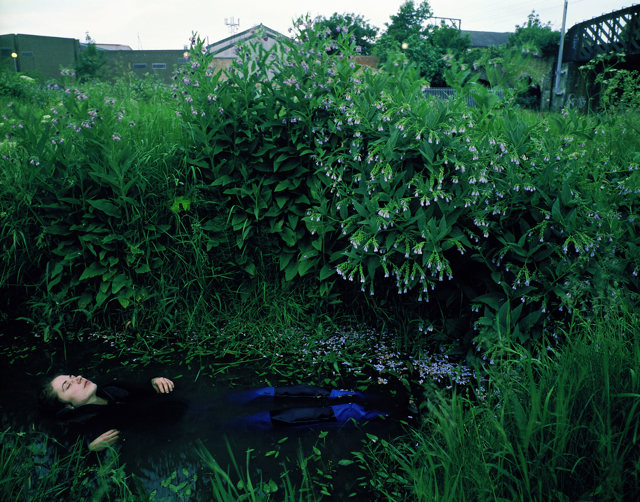
The Way Home from Life and Death in Hackney
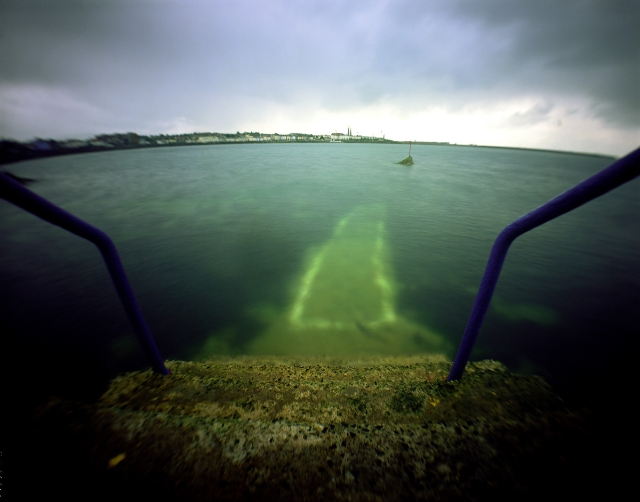
Dublin Bay Bathing Places
“A great sweet mother? The snot green sea. The scrotum tightening sea… Our mighty mother!”
— James Joyce, Ulysses
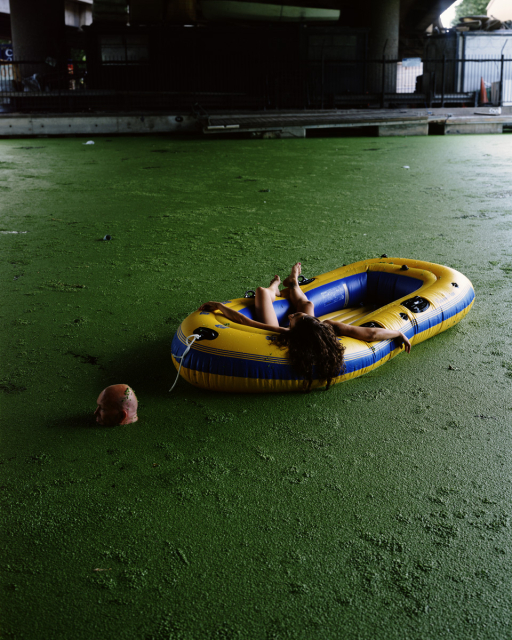
Hackney Cut from Unheralded Stories
 Painting by Andrew Wyeth "Christinas World"
Painting by Andrew Wyeth "Christinas World" Anchor and Hope from Unheralded Stories
Anchor and Hope from Unheralded Stories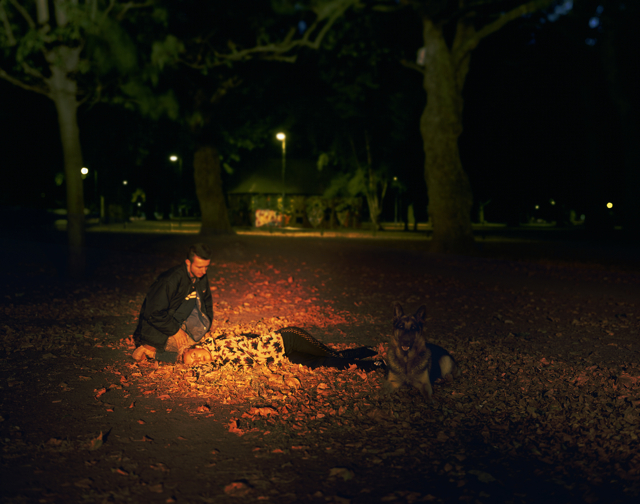
Murder Two Men Wanted from Living in Hell and Other Stories
It is frequently remarked upon how he tries to capture the beauty within the ugliness of his surroundings, incorporating nature in full glory with the industrial landscape not far behind. Sometimes he has faced criticism that he takes serious social issues and presents them more the manner of Fine Art rather than social documentary, however I don't think it matters how you get your message across as long as your voice is being heard and the issues are being discussed. There can be doubt that in this Hunter succeeds. He has often invoked controversy over the reality and partial nudity in some of his images. However, Hunter argues that many of the classical paintings on display show contain more nudity and controversial situations than his. The problem probably lies within the differences between reality versus a painting, but why should one be deemed more acceptable?
When asked about he approach to photography he admits that some of that is down to the equipment he uses and some of it a possible rebellion against the likes of Martin Parr. He feels there is nothing wrong in staging shots for a subject that could be classified as social documentary, that there is no "true documentary style" and that staging photographs is something that documentary photographers have always done to a lesser extent.
Hunter also discussed his commercial work, that gaining access to buildings can be difficult but persevere; asking in person and explaining your situation is often a better approach.Sometimes he has gained access where an assistant takes no for an answer! It was refreshing to hear that he feels that now he has "made it" there is more pressure on him to work harder, to come up with the next set of images and worries about if they will be well received.
All in all it was an entertaining and enlightening visit, Tom Hunter should be glad there wasn't a swear box in the room ;o) I think I gained a lot from his talk and the examination of his work. Although the majority of his work is set within a small area every set is different and has a different approach, he uses different equipment, even employing pin-hole cameras, self doubt is normal, grab inspiration from everything!
Thanks again to the OCA for organising this trip.
Tom Hunter
Thanks for reminding me of the visit. It really was a good one. Still have to do my own write-up!! the way he works is certainly an inspiration.
ReplyDelete